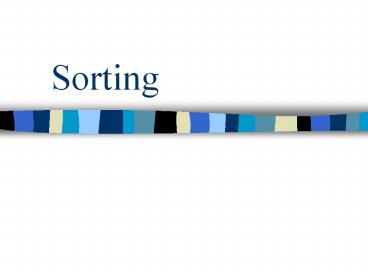Sorting - PowerPoint PPT Presentation
1 / 21
Title:
Sorting
Description:
Sorting Algorithms. Insertion Sort O( n2 ) Bubble Sort O( n2 ) Selection ... return l // return the first position in right position. Quicksort: Illustration ... – PowerPoint PPT presentation
Number of Views:33
Avg rating:3.0/5.0
Title: Sorting
1
Sorting
2
Sorting Terminology
- Sort Key
- each element to be sorted must be associated with
a sort key which can be compared with other keys - e.g. for any two keys ki and kj,
- ki gt kj , ki lt kj ,or ki kj
3
Sorting Terminology
- The Sorting Problem
- Arrange a set of records so that the values of
their key fields are in non-decreasing order.
4
Sorting Algorithms(Running Time Analysis)
- Things to measure
- comparisons bet. keys
- swaps
The measure of these things usually approximate
fairly accurately the running time of the
algorithm.
5
Sorting Algorithms
- Insertion Sort O( n2 )
- Bubble Sort O( n2 )
- Selection Sort O( n2 )
- Shellsort O( n1.5 )
- Quicksort O( nlog2n )
- Mergesort O( nlog2n )
- Heapsort O( nlog2n )
- Binsort O( n ) w/ qualified input
- Radix Sort O( n ) w/ qualified input
6
Insertion Sort Algorithm
- void insertionSort( Elem a, int n )
- for( int i 1 i lt n i )
- for( int j i (j gt 0) ( a j.key lt a
j-1.key) j-- ) - swap( a j, a j-1 )
7
Insertion Sort Illustration
8
Insertion Sort Time complexity
- outer for loop executed n-1 times
- inner for loop depends on how many keys before
element i are less than it. - worst case reverse sorted (each ith element must
travel all the way up) - running time (n-1)(n)/2 gt O( n2 )
- best case already sorted (each ith element does
not need to travel at all) - running time (n-1) gt O( n )
- average case (n-1)(n)/2 / 2 gt O( n2 )
9
Bubble Sort Algorithm
- void bubbleSort( Elem a, int n )
- for( int i 0 i lt n-1 i )
- for( int j n-1 j gt i j-- )
- if( a j.key lt aj-1.key )
- swap( a j, a j-1 )
10
Bubble Sort Illustration
11
Bubble Sort Time complexity
- number of comparisons in inner for loop for the
ith iteration is always equals to i - running time
- ? i n(n1)/2 ? O( n2 )
n i 1
12
Selection Sort Algorithm
- void selectionSort( Elem a, int n )
- for( int i 0 i lt n-1 i )
- int lowindex i
- for( int j n-1 j gt i j-- )
- if( a j.key lt a lowindex .key )
- lowindex j
- swap( ai, a lowindex )
13
Selection Sort Illustration
14
Selection Sort Time complexity
- number of comparisons in inner for loop for the
ith iteration is always equals to i - running time
- ? i n(n1)/2 ? O( n2 )
n i 1
15
Shellsort Algorithm
- void shellsort( Element a )
- for( int i a.length/2 i gt 2 i /2 )
- for( int j 0 j lt i j )
- insertionSort2( a, j, a.length-j, i )
- insertionSort2( a, 0, a.length, 1 )
- void insertionSort2( Element a, int start, int
n, int incr ) - for( int istartincr iltn iincr)
- for( ji (jgtincr) (a j.key lt a
j-incr.key) j-incr) - swap( aj, aj-incr )
16
Shellsort Illustration
17
Shellsort Time complexity
- O( n1.5 )
18
Quicksort Algorithm
- void quicksort( Elem a, int I, int j )
- int pivotindex findpivot( a, i, j )
- swap( apivotindex, arrayj ) // stick
pivot at the end - int k partition( a, i-1, j, aj.key ) // k
will be the first position in the right
subarray - swap( ak, aj ) // put pivot in place
- if( k-i gt 1 ) quicksort( a, i, k-1 ) // sort
left partition - if( j-k gt 1 ) quicksort( a, k1, j ) // sort
right partition - int findpivot( Elem A, int i, int j ) return
( (ij) / 2 ) - int partition( Elem A, int l, int r, Key pivot
) - do // move the bounds inward until they meet
- while( al .key lt pivot ) // move left
bound right - while( r a--r.key gt pivot ) // move right
bound left - swap( al, ar ) // swap out-of-place values
- while( l lt r ) // stop when they cross
- swap( al, ar ) // reverse last, wasted
swap - return l // return the first position in right
position
19
Quicksort Illustration
20
Quicksort Illustration
21
Quicksort Time complexity
- findpivot() takes constant time 0(1)
- partition() depends on the length of the sequence
to be partitioned - O(s) for sequence of length s
- Worst-case when pivot splits the array of size n
into partitions of size n-1 and 0. O(n2) - Best case when pivot always splits the array
into two equal halves. - There will be log2n levels (1st level one n
sequence, 2nd level two n/2 sequences, 3rd
level four n/4 sequences, ) O(nlog2n) - Average case O( n log2n )
- given by the recurrence relation
- T(n) cn 1/n ? ( T(k) T(n - 1 - k) ), T(0)
c , T(1) c
n-1 k 0































